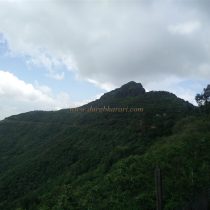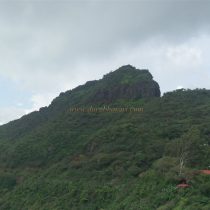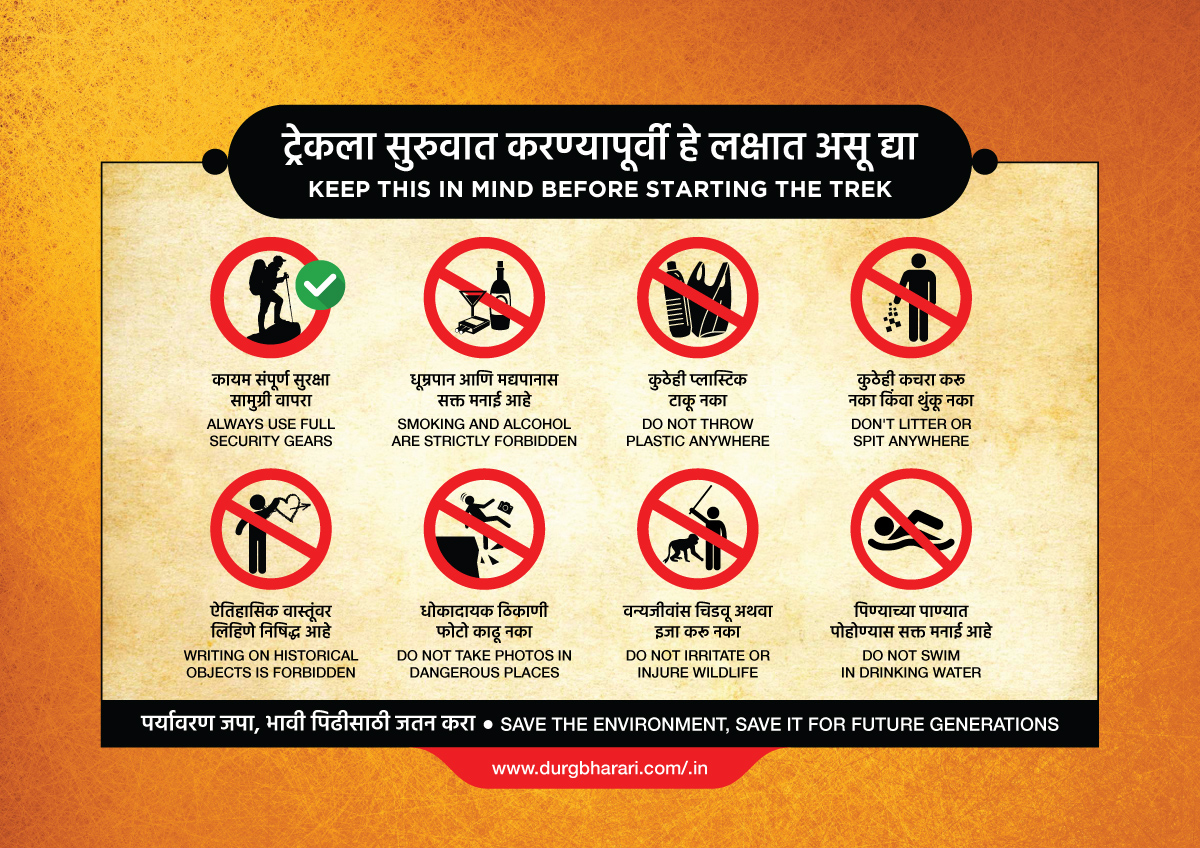VAJRAGAD
TYPE : HILL FORT
DISTRICT : PUNE
HEIGHT : 4265 FEET
GRADE : VERY HARD
There should not be another mountain near a fort. If so, it should be broken down and brought to the level of the fort and if that is not possible, the fort should be built and strengthened up to the height of the mountain.
--- Ramchandrapant Amatya.
According to this rule of forts, many joint-forts like Ankai-Tankai, Lohgad-Visapur, and Mangi-Tungi were built in Maharashtra. The fort of Purandar-Vajragad is famous in history due to the sacrifice of Murarbaji. Situated on the same hillside, the two forts are separated by a single pass. Vajragad fort is smaller in height and size than Purandar fort and the pass that separates them is known as Bhairavkhind. Although these are two separate forts, the only way to reach Vajragad is through the Bhairav pass at Purandar fort.
...
Both the forts, Vajragad and Purandar, are under the control of the Army, and shooting is practiced at Vajragad. As Purandar fort is higher than Vajragad, the top of Vajragad can be seen from it. Purandar Fort is at a distance of 45 km from Pune. After coming to Purandar fort by car and crossing the Murarbaji Deshpande statue, we come to the parking lot of the car. After stopping here and taking a straight road, we reach Bhairavkhind. There is a bust of Chhatrapati Shivaji Maharaj in this pass. Vajragad fort is a hill on the east side of this gorge. My journey to Vajragad has been only up to here and the following description is given after reading some books published before 2015. Starting from Bhairavkhind, we make our way through the Karwandi bush and reach the north-facing gate of the fort in half an hour. There are some steps built near the door and these steps are built between two bastions. Inside the door, you can see the porches of the guards on both sides. On the inside of this door is another small north-facing door with a sculpture carved in the center of its arch. Upon entering through this door, you directly enter the citadel. From the bastion, one can see the entire road leading to the fort from Bhairavkhind and the road leading to Purandar through Bini Darwaza. The top of the fort is 4260 feet above sea level and is spread east to west. There are two water cisterns on the upper left side of the door. In this area, you can see huge stones piled on top of each other. There is a small gate to go to the lower part of the fort from the citadel. When you go down through this door, there are 3 big cisterns carved in the rock. The water in all these cisterns is mossy and there are a Hanuman temple and Rudreshwar Shiv temple on the edge of the cistern. The idol of Lord Hanuman is in place of his temple, although, the Shivling of the Rudreshwar temple is not in place. Remains of a mansion can be seen on the hummock on the east side of the Rudreshwar temple. The east side of the trunk is enclosed by building a bastion. In this part of the trunk, except for a large fortified bastion, no other remains can be seen. There are two water cisterns on the north side of Rudreshwar temple. To the west of Vajragad, there is a double rampart on the Purandar side, and the bastion at the end has been severely damaged. From this bastion, one can see Purandar fort and the entire region on Machi. The ramparts of the fort are still in good condition and have five large bastions. The document mentions the name of one of these bastions as ‘Naginicha Buruj’, but it is not possible to say exactly which one it is. Vajragad is associated with the Purandar fort. According to a Puran story, Indranil Parvat is the mountain on which Indra performed Tapasya to get rid of the curse of sage Gautam. The name Purandar comes from Lord Indra and his weapon Vajra. The fort was built in front of Purandar and was named Vajragad. It is also known as Rudramal due to the Rudreshwar Shiv Temple on Vajragada. Looking at the ancient Kedareshwar temple at the foot of the fort, it must have been built during the Chalukya or Rashtrakut period before the Yadav period. As Vajragad is a sub-fort of Purandar, its history is related to Purandar. During the Bahamani period, Chandrasampat Deshpande of Bidar captured Purandar fort and rebuilt it. After the end of Bahamani rule, the fort came under Nizamshahi in 1489 AD and then to the Adilshahi in 1550 AD. When Adilshah sent Fateh Khan to deal with Shivaji Maharaj, Maharaj chose the place of Purandar fort for battle but the fort was not in the possession of Marathas. At this time Mahadji Nilkanthrao was the Adilshahi fort keeper on the fort. Taking advantage of their internal quarrel, Shivaji Maharaj entered the fort and took possession of it. The battle with Fateh Khan was won by the Marathas with the help of the Purandar fort. Shivaji Maharaj appointed Netaji Palkar as the fort keeper of Purandar in 1655. The initial administration of Swarajya started from this fort till the construction of Rajgad was completed. Sambhaji Raja was born on 16th May 1657 at Purandar fort. In 1665, Dilerkhan laid siege to Purandar but it did not have any effect on the fort. After the capture of Vajragad, The Mughals noticed that cannons could be easily fired at Purandar from Vajragad. At this time, Yashwant Buwaji Prabhu and his brother Babaji Buwaji Prabhu were at Vajragad with 300 Mavals on the fort. Dillerkhan brought three cannons and troops from Kapildhar's trunk under the northwest bastion of the fort and was ready in the stage of attacking the fort. The cannons were brought till here resisting the attacks from the Mavals on Vajragad. Abdul Khan, Fatehlashkar, and Maheli were the names of the cannons. These cannons started firing at Vajragada and on 13th April the northwest bastion of the fort collapsed. When the Mughals entered the fort, the internal forces resisted, but due to a large number of Mughals, the Marathas lost and the Mughal flag was hoisted on the fort on 14 April 1665. The Marathas were held captive and sent to Mirza Raje Jayasingh. Mirza Raja released everyone without any punishment so that even Purandar's army could leave the fort to save their own lives. But the Marathas did not leave and his trick failed. Adyakrantiveer Umaji Naik lived on this fort for some time. The prowess of the Purandar fort is related to the prowess of Vajragad.
© Suresh Nimbalkar




